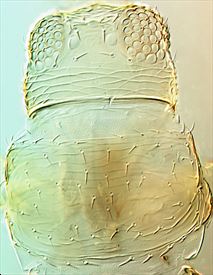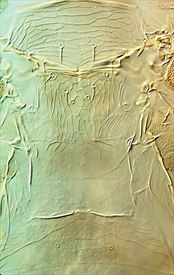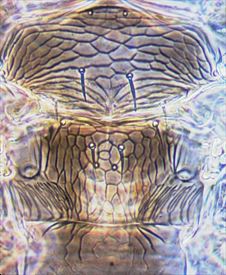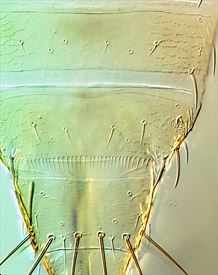Distinguishing features
Both sexes fully winged. Female, including legs, mainly yellow; abdominal tergites III–VI with median and anterolateral dark areas (varying in size and intensity); antennal segment I white, II variable from pale to brown, III yellow to light brown, IV–V brown but sometimes with bases paler; fore wings weakly shaded except at apex; tergite IX setae light brown. Head wider than long with transverse sculpture lines behind eyes, extending weakly into ocellar triangle; eyes without pigmented facets; ocellar setae III varying in position from anterior margins of triangle to close together behind first ocellus. Antennae 9-segmented, III & IV each with sense cone forked; VI pedicellate, suture transverse between VI–VII. Pronotum with transverse lines; with no long setae, discal setae relatively robust. Metascutum reticulate; median setae close to anterior margin; campaniform sensilla present. Fore wing first vein with about 9–11 setae on basal half, 2–4 setae medially, 2 setae distally; second vein with 12–16 setae including 1–2 setae basal to vein fork; clavus with 6–7 veinal setae. Abdominal tergites II–IV with a few sculpture lines medially, V–VII usually without such lines; laterally with about 8 anastomosing lines with broadly based, short microtrichia, sculpture extending just mesad of setae S2; VIII with long regular postero-marginal comb. Sternite VII setae S1 far anterior to posterior margin, S2 sometimes slightly submarginal.
Male similar to female; tergite IX with one pair of stout median thorn-like setae, posterior margin with pair of greatly elongate, recurved “setae”; sternites III–VII with large C-shaped pore plate.
Related species
Out of a total of 81 species of Anaphothrips worldwide, 43 are known from Australia (Mound & Masumoto, 2009) and five from New Zealand. A. dubius is similar in structure to the common species A. obscurus; but it has a shorter head, and the second vein of the forewing bears several setae proximal to the cross-vein. Moreover, in contrast to A. obscurus, A. dubius is known only from macropterae, and males have been collected in both Australia and New Zealand. The uniquely recurved “setae” on the posterior margin of tergite IX in males of A. dubius do not appear to have typical setal bases, and may be homologous with smaller structures in a similar position in two other species from Australia (Mound & Masumoto, 2009).
Biological data
This species feeds and breeds on leaves. In New Zealand, adults have been collected from the introduced plants Althaea rosea, Physalis peruviana, Anemone, Solanum nigrum and Nicotiana tabacum, and it has also been reared on Haloragis erecta. In Australia, adults with larvae have been found on Pandorea sp. (Bignoniaceae) and Xerochrysum bracteatum (Asteraceae), and adults taken from Urtica sp. (Urticaceae) and Dodonaea viscosa (Sapindaceae).
Distribution data
Known only from New Zealand and Australia. Probably native to Australia, where it is widespread in the Eastern States, feeding on the leaves of several species of dicotyledons. In New Zealand, the first recorded specimen was collected at Auckland from Nicotiana tabacum (Spiller, 1951, 1956). Only a few specimens have been collected subsequently (AK, WI / NN). Collected in December, January, February, July, and September.
Family name
THRIPIDAE, THRIPINAE
Species name
Anaphothrips dubius (Girault)
Original name and synonyms
Heterothrips dubius Girault, 1926: 2
Anaphothrips quinqueguttatus Girault, 1927: 2
Anaphothrips regalis Girault, 1928: 2
Hemianaphothrips (Anaphothrips) tersus Morison, 1930: 9
References
Mound LA & Masumoto M (2009) Australian Thripinae of the Anaphothrips genus-group (Thysanoptera), with three new genera and thirty-three new species. Zootaxa 2042: 1–76.
Spiller D (1951) Notes on Thysanoptera. New Zealand Journal of Science and Technology (B) 33: 142–143
Spiller D (1956) A check list of New Zealand Thysanoptera. New Zealand Entomologist 2: 11–14






